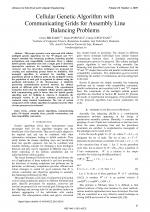| 2/2010 - 15 |
Cellular Genetic Algorithm with Communicating Grids for Assembly Line Balancing ProblemsBRUDARU, O. |
| Extra paper information in |
| Click to see author's profile in |
| Download PDF |
Author keywords
cellular genetic algorithms, communicating grids, I/U-shaped assembly lines, parallel workstations, and task compatibility constraints
References keywords
link(7), genetic(6), balancing(5), assembly(5), algorithms(5), line(4)
Blue keywords are present in both the references section and the paper title.
About this article
Date of Publication: 2010-05-31
Volume 10, Issue 2, Year 2010, On page(s): 87 - 93
ISSN: 1582-7445, e-ISSN: 1844-7600
Digital Object Identifier: 10.4316/AECE.2010.02015
Web of Science Accession Number: 000280312600015
SCOPUS ID: 77954656030
Abstract
This paper presents a new approach with cellular multigrid genetic algorithms for the I-shaped and U-shaped assembly line balancing problems, including parallel workstations and compatibility constraints. First, a cellular hybrid genetic algorithm that uses a single grid is described. Appropriate operators for mutation, hypermutation, and crossover and two devoration techniques are proposed for creating and maintaining groups based on similarity. This monogrid algorithm is extended for handling many populations placed on different grids. In the multigrid version, the population of each grid is organized in clusters using the positional information of the chromosomes. A similarity preserving communication protocol between the clusters placed on different grids is introduced. The experimental evaluation shows that the multigrid cellular genetic algorithm with communicating grids is better than the hybrid genetic algorithm used for building it, whereas it dominates the monogrid version in all cases. Absolute performance is evaluated using classical benchmarks. The role of certain components of the cellular algorithm is explained and the effect of some parameters is evaluated. |
| References | | | Cited By «-- Click to see who has cited this paper |
| [1] Ajenblit, D. A., Wainwright, R. L., "Applying genetic algorithms to the U-shaped assembly line balancing problem", In: Proceedings of the 1998 IEEE International Conference on Evolutionary Computation, Anchorage, Alaska, pp. 96-101, 1998. [CrossRef] [Web of Science Times Cited 49] [2] Alba, E., Troya, J. M., "An analysis synchronous and asynchronous parallel distributed genetic algorithms with structured and panmictic islands", In: IPPS/SPDP Workshops, pp. 248-256, 1999. [3] Brudaru, O., "Assembly line balancing with compatibility constraints", Econ. Comput. Econ. Cybern. Stud. Res. 27, No.1-4, pp. 59-65, (1993). [4] Gen, M., Cheng, R., Lin, L., "Assembly Line Balancing Models, Network Models and Optimization", Springer London, pp. 477-550, 2008. [5] Haynes, Th., Sen, S., "Evolving behavioral strategies in predators and pray", In IJCAI-95 Workshop on Adaptation and Learning in Multiagent Systems, pp. 32-37, 1995. [6] Li, X., Suterhand, S., A., "Cellular Genetic Algorithm Simulating Predator - Prey Interactions", Technical Report, School of Comp. Sci. and Information Technology, RMIT University Melbourne, 2006. [7] Michalewicz, Z., "Genetic Algorithms + Data structures = Evolution Programs", Springer Verlag, Berlin 1994. [8] Paszkowicz W., "Genetic Algorithms, a Nature-Inspired Tool: Survey of Applications in Materials Science and Related Fields", Materials and Manufacturing Processes, vol. 24, 2, Feb. 2009, pp. 174 - 197 [9] Scholl, A., "Balancing and sequencing of assembly lines". 2nd edition, Physica-Verlag, Heidelberg. [10] Tasan S., Tunali, S., "A review of the current applications of genetic algorithms in assembly line balancing", Journal of Intelligent Manufacturing, Springer Netherlands, vol. 19, Number 1 / February, pp. 49-69, 2008. [CrossRef] [Web of Science Times Cited 118] [SCOPUS Times Cited 141] [11] Temporary on-line reference link removed - see the PDF document [12] Temporary on-line reference link removed - see the PDF document [13] Temporary on-line reference link removed - see the PDF document [14] Temporary on-line reference link removed - see the PDF document [15] Temporary on-line reference link removed - see the PDF document [16] Temporary on-line reference link removed - see the PDF document [17] Temporary on-line reference link removed - see the PDF document Web of Science® Citations for all references: 167 TCR SCOPUS® Citations for all references: 141 TCR Web of Science® Average Citations per reference: 10 ACR SCOPUS® Average Citations per reference: 8 ACR TCR = Total Citations for References / ACR = Average Citations per Reference We introduced in 2010 - for the first time in scientific publishing, the term "References Weight", as a quantitative indication of the quality ... Read more Citations for references updated on 2024-11-24 09:28 in 16 seconds. Note1: Web of Science® is a registered trademark of Clarivate Analytics. Note2: SCOPUS® is a registered trademark of Elsevier B.V. Disclaimer: All queries to the respective databases were made by using the DOI record of every reference (where available). Due to technical problems beyond our control, the information is not always accurate. Please use the CrossRef link to visit the respective publisher site. |
Faculty of Electrical Engineering and Computer Science
Stefan cel Mare University of Suceava, Romania
All rights reserved: Advances in Electrical and Computer Engineering is a registered trademark of the Stefan cel Mare University of Suceava. No part of this publication may be reproduced, stored in a retrieval system, photocopied, recorded or archived, without the written permission from the Editor. When authors submit their papers for publication, they agree that the copyright for their article be transferred to the Faculty of Electrical Engineering and Computer Science, Stefan cel Mare University of Suceava, Romania, if and only if the articles are accepted for publication. The copyright covers the exclusive rights to reproduce and distribute the article, including reprints and translations.
Permission for other use: The copyright owner's consent does not extend to copying for general distribution, for promotion, for creating new works, or for resale. Specific written permission must be obtained from the Editor for such copying. Direct linking to files hosted on this website is strictly prohibited.
Disclaimer: Whilst every effort is made by the publishers and editorial board to see that no inaccurate or misleading data, opinions or statements appear in this journal, they wish to make it clear that all information and opinions formulated in the articles, as well as linguistic accuracy, are the sole responsibility of the author.





